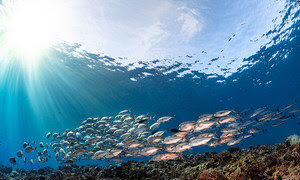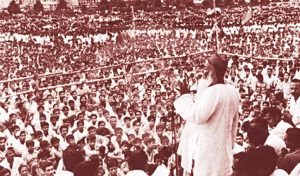The Ministry of Water Resources of the Union Government of India has on Oct 11, 2017 (see notice: http://www.wrmin.nic.in/forms/List.aspx?lid=1180&Id=6) put up draft guidelines on Groundwater management in India (see draft Guidelines: http://www.wrmin.nic.in/writereaddata/guideline-NOC-CGWA.pdf), with comments period of 60 days. The comments are to be sent to Member Secretary, Central Ground Water Authority, West Block-2, Wing 3 (Ground Floor), Sector 1, RK Puram, New Delhi – 110066, e-mail: cgwa@nic.in.New Draft Groundwater guidelines designed to destroy groundwater further and open floodgates for privatisation of common property resource? “Groundwater is a common property resource and should be used for greater good. But these guidelines are not doing that. Groundwater governance and management should happen in a transparent, participatory and accountable way but that too is not happening through guidelines,” Thakkar said.
Explaining, Thakkar said that the guidelines are “trying to make a system wherein state or district level authorities will be giving NOCs but whether those authorities have the capacity to give NOCs after understanding the implications is the question.” “The draft guidelines also take out the need to recharge groundwater. Present regulations say that you if you take out groundwater you need to put in recharge capacity but now they are saying that’s not necessary and are only seeking charges. These things will definitely lead to further destruction of groundwater,” he added. http://www.livemint.com/Politics/irx1jFCWMFjGJk82Z8VZ2O/Govt-proposes-new-guidelines-on-groundwater-usage-by-industr.html, http://www.newindianexpress.com/nation/2017/oct/13/centre-proposes-water-conservation-fee-for-use-of-groundwater-1673480.html, http://www.newindianexpress.com/nation/2017/oct/14/townships-with-gym-club-must-pay-water-fee-1673790.html, http://www.hindustantimes.com/environment/centre-proposes-nixing-recharge-requirement-for-industries-extracting-groundwater/story-kN3iPmO9m4MIoYkUX32n7I.html
CBI registers corruption case against scientist of CGWB The Central Bureau of Investigation has registered a corruption case against a scientist – Sanjay Pandey – of Central Ground Water Board (CGWB), a technician – Chander Prakash Midha – of Institute of Microbial Technology (CSIR, department of scientific and industrial research) among others for allegedly taking Rs 1.5 lakh to Rs 2 lakh each from various private industries in Haryana and Punjab for recommending issuance of NOC for them for extracting groundwater for industrial use.
Officials said that Pandey, Scientist B, posted at CGWB in Chandigarh, and Midha are very close to each other and connived to get money from industries in Haryana and Punjab. They got their applications forwarded from regional officer of CGWA in Delhi, with recommendation of issuance of NOCs/permission to extract ground water for the industrial use.CBI sources said that they are probing role of other persons in the alleged irregularities. https://timesofindia.indiatimes.com/india/cbi-registers-corruption-case-against-scientist-of-central-ground-water-board/articleshow/61039443.cms
Punjab Centre alerts state over decline in water table The Union Govt has red-flagged a sharp decline in the groundwater level in Punjab. As per a study conducted in May, 94 per cent of the state has shown a decline in the water level when compared to the average level from 2007-16. Despite that, the Punjab Govt is adamant on keeping the “politically sensitive” free power to agriculture consumers going a major reason for excessive tubewell connections that drain the groundwater. There is also no action plan to wean away farmers from water guzzling paddy crop. http://www.tribuneindia.com/news/punjab/centre-alerts-state-over-decline-in-water-table/474587.html
Uttar Pradesh NGT asks Govt reasons for not sealing illegal borewells This is sad to see the lethargic approach of the Central and State Govt agencies to take actions on important issue of ground water depletion despite NGT direction. CGWA says it has identified the industries with illegal bore a well, while UP Govt says C GWA has not handed over the list to Govt hampering its actions. Earlier, the NGT had directed CGWA to submit a detailed report on industries in Ghaziabad and Hapur after a plea alleged that incessant extraction of groundwater has resulted in depletion of the water table. http://www.india.com/news/agencies/explain-reasons-for-not-sealing-illegal-borewells-ngt-to-up-2518446/
Tamil Nadu 2015 floods recharged Chennai’s groundwater, but polluted it As per research by Anna University has found, the 2015 floods may have recharged aquifers across the city, but it contaminated the groundwater with bacteria and chemical ions. Bacterial counts and chemical ions in groundwater samples collected across the city exceeded Bureau of Indian Standard’s (BIS) recommended limits, concludes the research recently published in `Nature’. Samples were collected from 22 areas along the Adyar River in a research by Anna University has found river soon after the floods and six months later in April 2016. https://timesofindia.indiatimes.com/city/chennai/2015-floods-recharged-chennais-groundwater-but-polluted-it/articleshow/61045967.cms
Maharashtra Groundwater in Pune ‘second-most contaminated’ According to a recent analysis of water quality, conducted by the Groundwater Survey and Development Agency (GSDA), with a total of 22 villages, Pune district is second in the state, after Chandrapur, to have the highest number of villages whose groundwater quality was not “readily fit for human consumption”, revealed the report. It further named Daund, Ambegaon and Indapur among the “most affected areas” in the district. According to hydrologists industrial effluents being dumped without effective treatment into rivers is a major contributor to the declining quality of groundwater in the area.” http://indianexpress.com/article/cities/Pune/state-wise-survey-groundwater-in-pune-district-second-most-contaminated-4863108/ – from SANDRP Bulletin




